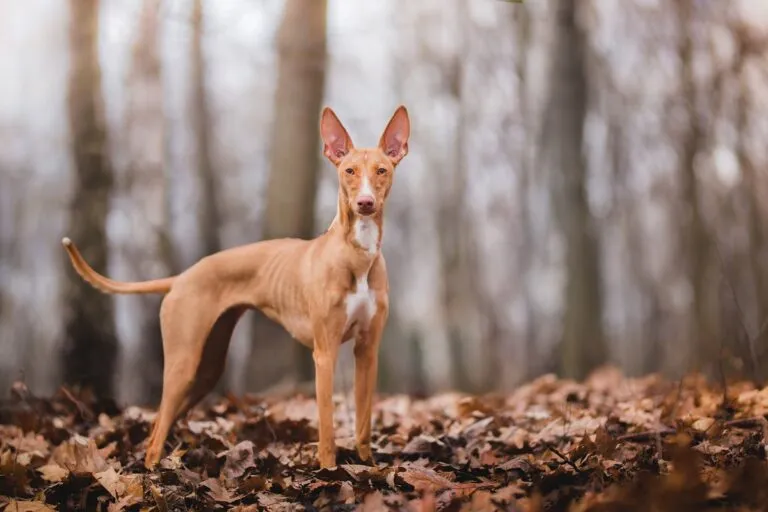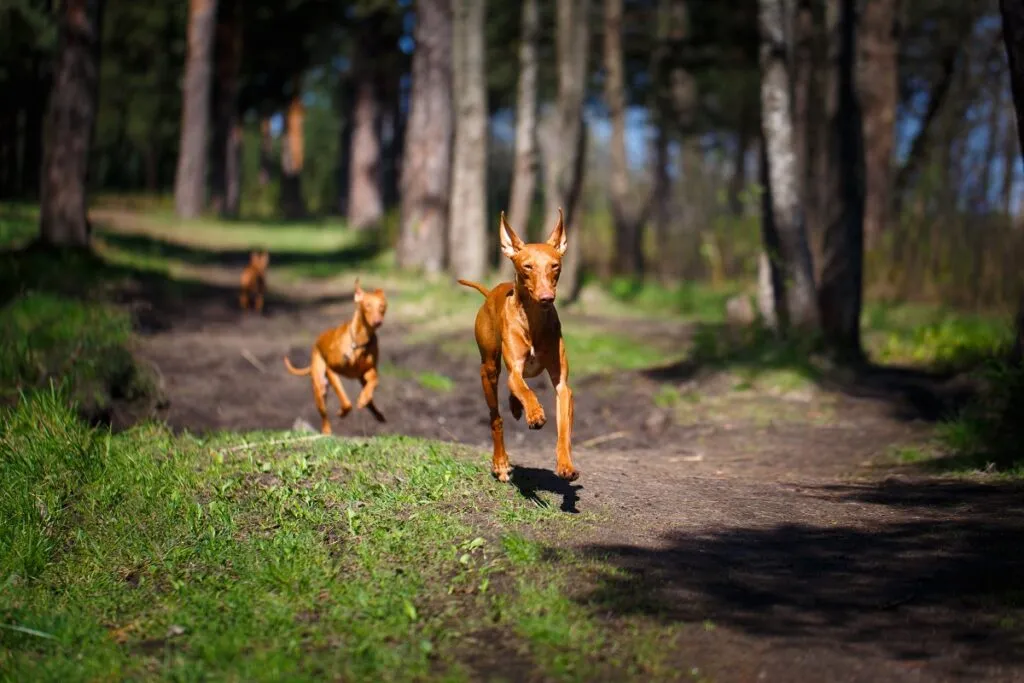Medium Size Poodle
The Cirneco dell'Etna is a sporty hunting dog from Italy, notable not only for its elegant appearance but also for its distinctive character. Learn more here about this breed, which is rarely found outside its homeland.

© Justyna / stock.adobe.com
The elegant and sporty Cirneco dell'Etna is also called the Sicilian Greyhound.
Grace and elegance characterise the medium-sized, delicate Cirneco dell’Etna, also known as the Sicilian Greyhound. As its secondary name suggests, this pooch has an athletic build.
The upright, high-set, and large ears are reminiscent of depictions of the ancient Egyptian god Anubis.
And if you’re now thinking of the Pharaoh Hound, you’re on the mark: the two breeds are highly similar, although the Pharaoh Hound is slightly larger.
The Cirneco’s coat is fine, around 2.5 centimetres in length, and comes in shades of fawn or reddish.
Accepted markings include white patches on the head, chest, belly, paws and the tip of the tail, as well as tan coloured dogs. Eye colours range from ocher to amber and light brown.
Males reach a height at withers of 46 to 50 centimeters and weigh up to 13 kilograms. Females measure between 44 and 48 centimetres, tipping the scales between 8 and 11 kilograms.
Despite its delicate appearance, the Cirneco is an free spirit with a strong hunting instinct.
Within this slender dog lies an impressive character – a passionate rabbit hunter. Accordingly, members of the breed are active and eager hunters even today.
The Cirneco dell’Etna is friendly and attentive towards its human companions. This intelligent pooch learns quickly but will critically assess what it has learnt before implementing it in everyday life.
The Cirneco remains an independent dog at heart, one that won’t always willingly follow commands everywhere and every time.
Even the FCI standard highlights this breed’s “strong-willed” nature, which is something to consider during dog training.
Hunting is a significant passion for almost all representatives of the breed – they love to follow their noses. However, they also find potential prey visually attractive.
For these dogs, once they have a wild animal in their sights or a scent trail, there’s no stopping them! An anti-hunting training initiated from puppyhood can allow some Cirnecos the freedom of off-leash play.
But if recall commands are not reliably followed, the dog should only be off-leash in a fenced area or be walked with a long leash.
Another aspect of training to bear in mind is the barking: most Cirnecos are territorial and express themselves with vigorous barking. But they don’t bark only when defending their patch; excitement or pure delight can also set them off.
Accordingly, the Cirneco is known as a vocal breed. Anyone considering adopting a Cirneco should not be oversensitive and ideally, not live in an acoustic-sensitive dwelling. Vocal expression is part of this breed’s nature.
Caring for this four-legged Italian is simple – regular brushing with a soft brush is sufficient to maintain its short coat. This also reduces shedding during the moulting period, which many dogs actually enjoy as part of their coat care.
Provided the Cirneco dell’Etna has sufficient activity, it can adapt to life in an apartment. However, a house with a well-fenced garden is the optimal choice for this energetic canine.
Here, it can romp freely without a lead. Because this dedicated hunting dog doesn’t discriminate against cats, it’s wise to ensure the fence is secured externally and there are no nearby trees to tempt an escape.
A Cirneco dell’Etna that is well-exercised behaves quietly indoors and is known for its tidiness.
The dog can get along excellently with children, provided it has enough personal space. Many Cirneci enjoy long play sessions with young human family members.
Naturally, one should never leave a dog and child unsupervised. Additionally, these dogs can live harmoniously with other dogs.
Socialising them with cats tends to be most successful with puppies. If the Cirneco is already fully grown when it meets a cat, it might regard the feline as prey.
The thrill of the hunt isn’t the only thing that brings the Cirneco joy. While independent, this pooch also enjoys working alongside its human partner.
Dog sports like mantrailing or other scent work are ideal for this breed. Agility and especially chasing a dummy hare during coursing can also provide immense delight to these diminutive dynamos.
The Cirneco dell’Etna is a versatile hunter, utilising both sight and scent. In addition to hunting rabbits, this breed can also pursue wild boar, partridges and even engage in waterfowl work. Unlike pointing breeds, the Cirneco hunts like a hound, nose to the ground.
In its homeland, during rabbit hunts, it drives rabbits out and chases them towards the hunter’s gun. The dog skillfully overcomes rocky terrain and steep stone passages.
However, many Cirnecos have a tendency to catch and consume their quarry. The breed benefits from formal hunting dog training.
A healthy Cirneco requires no special dog food. Look for a high-quality, well-tolerated food with a high meat content.
Some dogs of this breed may drink too little; in these cases, ensure sufficient water intake and, if necessary, a higher moisture content in their food.
The ancestors of the Cirneco dell’Etna hail from Sicily, where dogs of this type have existed for millennia. The name is likely derived from the Greek colony of Cyrenaica in Libya and from Mount Etna.
Around the volcano, the breed’s forebears adapted to rabbit hunting over nooks and craggy ledges. Numerous coins, carvings, and mosaics from the region have depicted the Cirneco dell’Etna since the 6th century BC.
Today, terms such as “Etna dog” or “Lava dog” occasionally reference the Cirneco. Further south, evidence of dogs resembling the modern Cirneco dell’Etna can be found, like on the famous “Cave Canem” mosaic from Pompeii.
The once-popular theory that the dogs arrived in the Mediterranean with the Phoenicians from Ancient Egypt is now contested. In 1947, the FCI recognised the Cirneco dell’Etna as a distinct breed.
 © DragoNika / stock.adobe.com
© DragoNika / stock.adobe.com
The Cirneco dell’Etna may seem fragile, but it is characterised by considerable robustness and endurance. There are no breed-specific diseases.
A healthy Cirneco dell’Etna can live up to 14 years.
These Italian dogs are lovers of warmth and appreciate cosy spots during the cold season. A dog coat can make winter more bearable for them. There are no breed-specific diseases.
The breed is extremely rare outside its native land. For example, the last official litter in Germany was in 2010.
Finding a purebred Cirneco dell’Etna can be challenging. Most active breeders are located in Italy.
Prices vary, but for a purebred puppy of the Cirneco dell’Etna breed, expect to pay at least £1000. Prices typically range from £1200 and upwards.
Visually similar to the Cirneco is the marginally larger Pharaoh Hound from Malta. The two breeds also share a comparable character.
The Cirneco dell’Etna also shares not just its svelte stature with many Podencos, but also their passion for hunting.
Even in animal rescue, dog lovers can find similar canines. Many Galgos looking for new homes exhibit similar traits.
The Cirneco dell’Etna is a captivating dog personality. Owing to its passion for hunting, this breed is suited only for dog enthusiasts who can provide ample mental and physical exercise, even without off-leash time, and appreciate its strong-willed character.
| Unique Traits: | This slender Italian dog resembles the Pharaoh Hound. Other names for the breed include: Sicilian Hound, Etna Dog, Sicilian Bracke, and Sicilian Greyhound. |
| Character: | affectionate, keen on hunting, athletic, independent |
| Heaight at Withers: | males: 46-50 cm; females: 44-48 cm |
| Weight: | males: up to 13 kg; females: up to 11 kg |
| Coat: | medium length (2.5 cm); mostly fawn coloured, white markings and tan colour accepted, smooth |
| Coat Care: | low maintenance, very tidy in the home, brush once a week, average shedding during moulting |
| Exercise: | requires a lot of mental and physical activity |
| Suitable for First-Time Owners: | no |
| Barking: | prone to frequent and sustained barking |
| Lifespan: | 12 – 14 years |
| Typical Diseases: | robust breed, no known hereditary diseases |
| Price: | £1000 to £1500 |
| FCI Group: | 5 – Spitz and Primitive types |
| Origin: | Italy |
Here are some purchase proposals curated by the zooplus editorial team
The products featured have been carefully selected by our editorial staff and are available at the zooplus online pet shop. The selection does not constitute advertising for the mentioned brands.
Fans of the Bearded Collie agree that those who aren't familiar with this dog breed simply have to get acquainted with it. And those who have experienced how a Bearded Collie bolts across meadows with its flowing fur, how it rolls around full of energy and joy and how it attentively and observantly takes into account its owners wishes become simply addicted to this original dog breed and its unique charm.
The Goldendoodle isn't a breed, but a pairing between Golden Retrievers and Medium or Standard Poodles. Marketed as a low-maintenance dog for allergy sufferers, this hybrid is enjoying increasing popularity amongst dog lovers, similar to the Labradoodle.